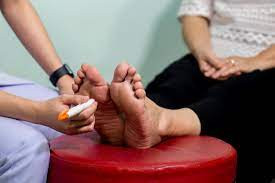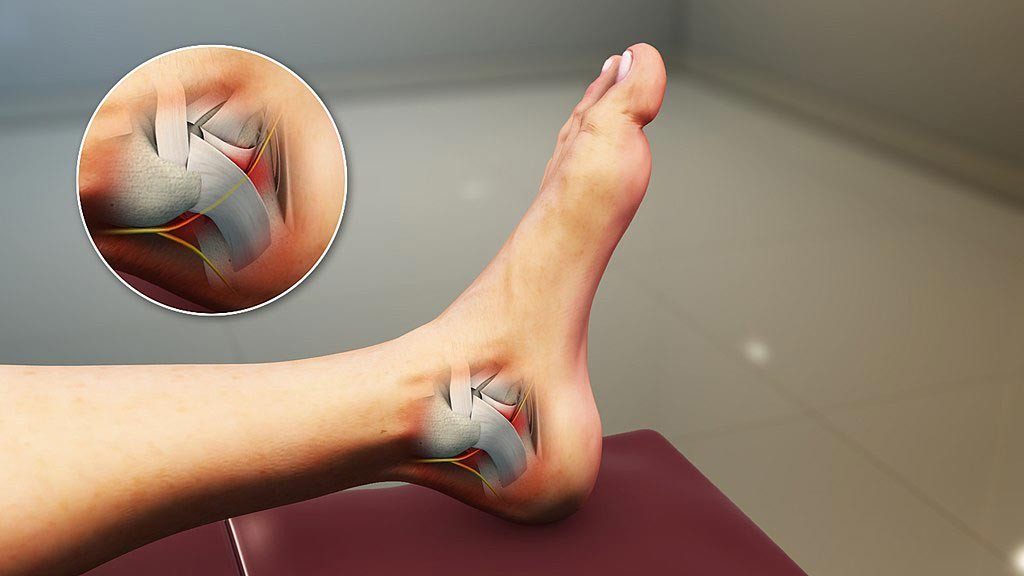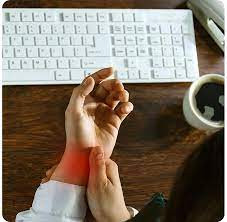Definisi
Charcot-Marie-Tooth, yang memiliki nama lain Hereditary Motor and Sensory Neuropathy (HMSN), adalah suatu kelompok penyakit bawaan yang menyebabkan kerusakan saraf. Gejala dapat muncul sejak lahir dan diturunkan secara genetik yang berdampak pada kerusakan saraf tepi, seperti saraf pada lengan dan kaki. Nama dari penyakit ini diambil dari nama tiga orang ilmuwan yang pertama kali menemukan penyakit ini pada tahun 1886, yakni Jean-Martin Charcot, Pierre Marie, dan Howard Henry Tooth.
Penyakit Charcot-Marie-Tooth menyebabkan otot menjadi lebih kecil dan lemah. Dapat juga merasakan hilangnya sensasi rasa terhadap rangsangan nyeri dan suhu, kehilangan kemampuan kontraksi otot dan kesulitan berjalan. Gejala biasanya muncul terlebih dahulu di bagian kaki serta telapak, dan berlanjut ke lengan dan tangan.
Di Amerika Serikat, penyakit ini cukup sering terjadi dan menjadi salah satu penyakit genetik terbanyak pada sistem saraf. Diperkirakan ada 126.000 orang di Amerika Serikat dan 2.6 juta orang yang terkena penyakit ini.
Penyebab
Penyakit Charcot-Marie-Tooth disebabkan oleh adanya mutasi genetik pada gen yang membentuk dan memelihara sel tabung saraf dan akson yang bertugas untuk mengirimkan sinyal ke saraf lain. Mutasi genetik diartikan sebagai perubahan susunan gen yang tidak normal pada DNA manusia. Charcot-Marie-Tooth terjadi ketika perubahan pada gen yang membentuk dan memelihara sel tabung saraf dan akson. Mutasi genetik ini dapat diturunkan oleh salah satu atau kedua orang tua, dan tidak menular melalui kontak maupun udara.
Faktor risiko
Karena penyakit ini adalah penyakit bawaan atau keturunan, maka risiko seseorang mengalami Charcot-Marie-Tooth meningkat bila ada anggota keluarga mengalami hal yang sama. Selain itu, penyebab gangguan saraf lainnya adalah diabetes yang dapat menimbulkan gejala yang mirip dengan penyakit Charcot-Marie-Tooth. Bila penyakit Charcot-Marie-Tooth dan diabetes terjadi secara bersamaan, maka gejala yang ditimbulkan dapat menjadi lebih buruk. Pengobatan seperti kemoterapi juga dapat memperburuk gejala, maka dari itu laporkan seluruh
Gejala
Tanda dan gejala dari penyakit ini biasanya muncul pada usia remaja atau usia dewasa awal, tapi dapat berkembang dan memburuk pada usia paruh baya. Karena penyakit ini bersifat progresif, maka gejala yang terlihat adalah ketika penyakitnya memburuk. Gejalanya antara lain adalah:
- Kelemahan pada tungkai, tumit, dan telapak kaki
- Penurunan massa dan besar otot pada tungkai beserta telapak
- Memiliki kelengkungan telapak kaki yang tinggi
- Kelainan bentuk pada otot ibu jari kaki (hammertoes)
- Penurunan kemampuan untuk berlari
- Kesulitan untuk mengangkat tumit
- Kelainan cara berjalan (gait problems)
- Sering terjatuh atau tersandung
- Penurunan sensasi atau mati rasa pada bagian telapak kaki dan tungkai
Diagnosis
Dokter akan melakukan pemeriksaan sesuai dengan alur yang berlaku. Dimulai dengan melakukan sesi tanya jawab ke pasien, melakukan pemeriksaan fisik, dan melakukan pemeriksaan penunjang.
Dari sesi tanya jawab, dokter akan menanyakan keluhan pasien, keluhan penyerta, sudah berapa lama keluhan-keluhan tersebut muncul, riwayat pekerjaan dan aktivitas sehari-hari, riwayat terjadi cedera, riwayat pengobatan, riwayat penyakit terdahulu, dan riwayat penyakit pada keluarga, terutama apakah ada anggota keluarga yang menderita penyakit Charcot-Marie-Tooth atau tidak.
Dilanjutkan dengan pemeriksaan fisik. Dokter akan melakukan pemeriksaan fisik secara menyeluruh. Selanjutnya dokter akan melakukan pemeriksaan yang lebih spesifik guna memeriksa kekuatan otot dan kemampuan saraf. Pemeriksaan kekuatan otot dilakukan dengan melihat perubahan bentuk dari lengan dan tungkai serta telapak, kemudian memeriksa kemampuan bergerak pada tungkai dan lengan. Pemeriksaan kemampuan saraf dilakukan dengan merangsang rasa nyeri, suhu, dan perubahan posisi.
Selanjutnya dokter akan melakukan pemeriksaan penunjang untuk mendukung diagnosis, sebagai berikut:
- Pemeriksaan genetik dengan mengambil sampel darah.
- Pemeriksaan elektromiografi (EMG) untuk memeriksa aktivitas elektrik pada saraf dan otot.
- Pemeriksaan studi konduksi saraf untuk mengukur kekuatan dan kecepatan dari sinyal listrik.
- Biopsi saraf, dilakukan dengan mengambil sebagian kecil jaringan saraf dan dilihat dibawah mikroskop.
Tata laksana
Sejauh ini belum ditemukan tata laksana untuk menyembuhkan penyakit Charcot-Marie-Tooth. Penyakit ini pun jarang mengancam nyawa. Namun penyakit ini dapat menurunkan kualitas hidup dari penderitanya. Oleh karena itu, tata laksana yang dilakukan bertujuan sebagai terapi pendukung dan bertujuan meningkatkan kualitas hidup dari pasien. Tata laksana tersebut antara lain adalah:
- Terapi fisik
Terapi fisik berguna menguatkan dan meregangkan otot sehingga mencegah kekakuan dan kehilangan fungsi otot. Terapi yang dilakukan meliputi latihan peregangan yang diajarkan oleh terapis atau fisioterapis yang sudah ditunjuk oleh dokter. Dengan melakukan terapi ini disabilitas otot dapat dicegah.
- Terapi okupasi
Terapi okupasi berguna untuk membantu keseharian penderitanya agar tetap bisa melakukan aktivitas sehari-hari dengan mudah. Tak jarang penyakit Charcot-Marie-Tooth menyebabkan kesulitan bergerak pada telapak tangan dan jari, sehingga terapi okupasi berfokus pada gerakan menggenggam dan fleksibilitas jari, seperti menulis, atau mengancingkan baju.
- Penggunaan alat ortopedi
Alat ortopedi tertentu seperti sepatu bot, atau sepatu dengan penyangga tumit tambahan dapat memperbaiki cara berjalan. Selain itu penggunaan alat ortopedi juga dapat memelihara mobilitas dan mencegah cedera pada tungkai dan telapak kaki.
- Tindakan operasi
Tindakan operasi menjadi pilihan pada kasus yang menimbulkan kelainan bentuk yang cukup parah. Operasi pada telapak kaki dapat membantu mengurangi rasa nyeri dan memperbaiki kemampuan berjalan, namun jika terasa mati rasa atau adanya penurunan sensasi sensorik, maka operasi tidak dapat membantu.
- Mengikuti komunitas sesama penderita Charcot-Marie-Tooth
Dengan mengikuti grup atau komunitas sesama penderita Charcot-Marie-Tooth, maka penderitanya dapat berbagi dan mendapat pengalaman mengenai penyakit ini sehingga saling memberikan dukungan secara psikis untuk meningkatkan kualitas hidup kedepannya.
Komplikasi
Komplikasi dari penyakit Charcot-Marie-Tooth bergantung pada derajat keparahan setiap orang. Kelainan pada telapak kaki dan kesulitan berjalan menjadi masalah serius yang utama. Otot juga dapat menjadi lebih lemah, dan dapat mengalami luka serta cedera lebih sering karena gangguan pada akson di saraf yang menyebabkan sinyal “nyeri” tidak tersampaikan sehingga penderitanya tidak sadar bahwa kakinya terluka. Selain itu, penderitanya dapat mengalami kesulitan bernapas, menelan, atau berbicara bila otot-otot yang berfungsi untuk melakukan aktivitas tersebut terdampak dari penyakit Charcot-Marie-Tooth.
Pencegahan
Tidak ada cara pencegahan khusus untuk mencegah penyakit Charcot-Marie-Tooth karena penyebabnya diturunkan secara genetik. Namun, melakukan skrining dengan memeriksakan diri ke dokter spesialis saraf pada usia remaja atau dewasa muda dapat menjadi langkah pencegahan bila terdapat riwayat yang sama dengan anggota keluarga yang lain.
Selain itu, bila memiliki rencana untuk menikah atau memiliki anak, lakukanlah skrining sebelum menikah untuk mengetahui ada tidaknya riwayat penyakit Charcot-Marie-Tooth di keluarga kedua pasangan.
Walaupun begitu, disarankan untuk tetap melakukan pola hidup sehat seperti memenuhi asupan kebutuhan nutrisi dan cairan dengan makan dengan pola gizi seimbang, minum air putih 1,5 hingga 2 liter per hari, menghindari rokok dan konsumsi alkohol, tetap bergerak aktif dan berolahraga intensitas sedang minimal 150 menit per minggu.
Kapan harus ke dokter?
Disarankan segera berobat ke dokter bila terjadi penurunan fungsi bergerak, dan mati rasa pada bagian tungkai dan telapak. Terutama bila memiliki riwayat anggota keluarga yang mengalami penyakit Charcot-Marie-Tooth. Segera berobat ke dokter spesialis saraf guna mendapatkan penanganan yang tepat.
- dr Vivian Keung
John Hopkins Medicine – Charcot-Marie-Tooth Disease. (2021). Retrieved 13 September 2022, from https://www.hopkinsmedicine.org/health/conditions-and-diseases/charcotmarietooth-disease
Mayo Clinic – Charcot-Marie-Tooth Disease. (2021). Retrieved 13 September 2022, from https://www.mayoclinic.org/diseases-conditions/charcot-marie-tooth-disease/diagnosis-treatment/drc-20350522
National Institute of Neurological Disorders and Stroke – Charcot-Marie-Tooth Disease Fact Sheet. (2018). Retrieved 13 September 2022, from https://www.ninds.nih.gov/charcot-marie-tooth-disease-fact-sheet
National Healthcare Services – Overview Charcot-Marie-Tooth Disease. (2019). Retrieved 13 September 2022, from https://www.nhs.uk/conditions/charcot-marie-tooth-disease/











